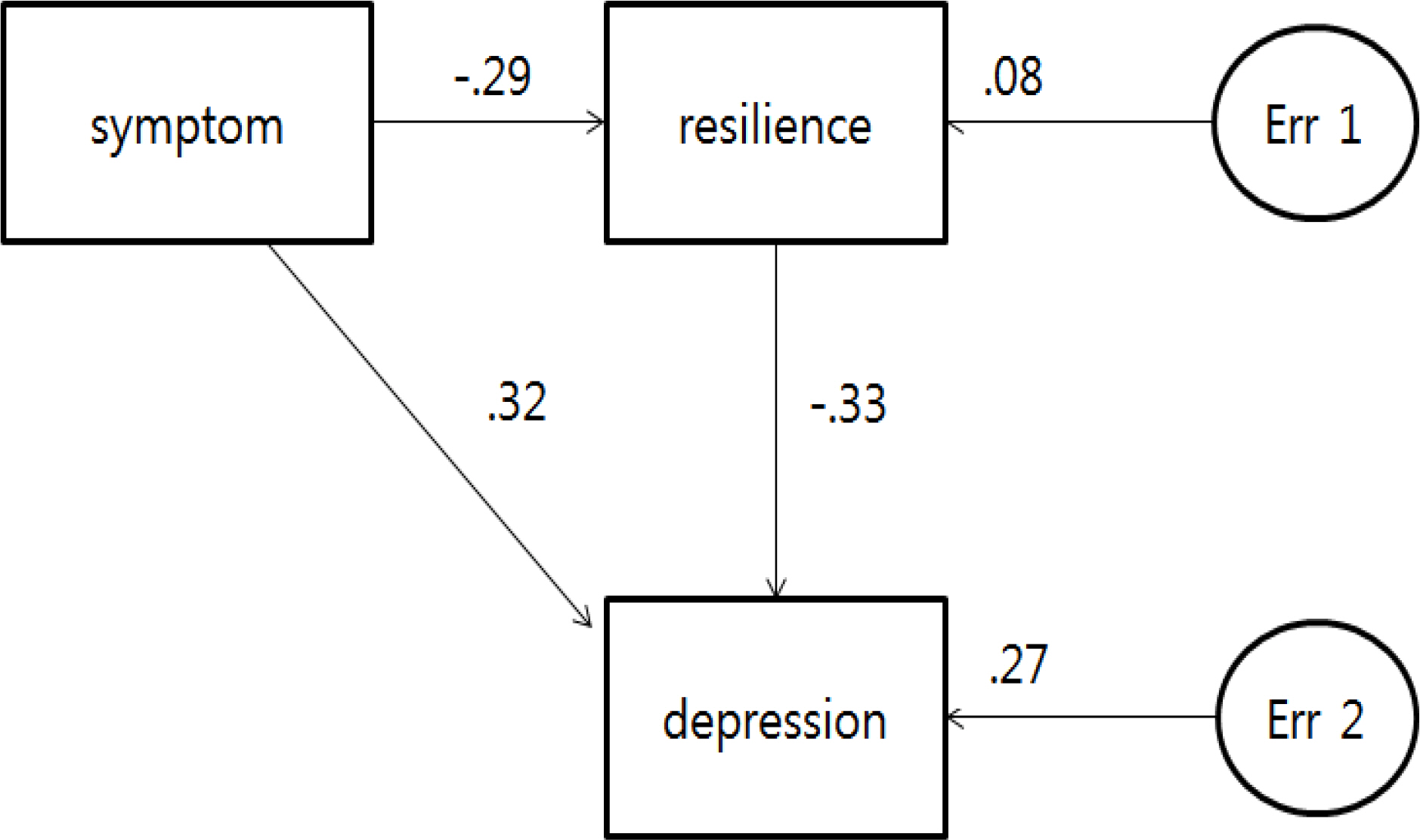Department of Nursing, Dong-A University, Busan, Korea
Copyright © 2015 Korean Society of Adult Nursing
This is an Open Access article distributed under the terms of the Creative Commons Attribution Non-Commercial License (http://creativecommons.org/licenses/by-nc/3.0) which permits unrestricted non-commercial use, distribution, and reproduction in any medium, provided the original work is properly cited.
| Variables | n (%) or M±SD | Range |
|---|---|---|
| Symptoms | 15.56±10.67 | 0~63 |
| Resilience | 86.11±9.93 | 25~125 |
| Depression | 5.70±4.14 | 0~15 |
| Normal group (<8) | 93 (61.6) | |
| Depressive group (≥8) | 58 (38.4) |
| Variables | Symptoms | Resilience | Depression |
|---|---|---|---|
| r (p) | r (p) | r (p) | |
| Symptoms | 1 | ||
| Resilience | -.29 (<.001) | 1 | |
| Depression | .42 (<.001) | -.42 (<.001) | 1 |


General and Disease-related Characteristics of the Subjects (N=151)
| Variables | Categories | n (%) or M±SD |
|---|---|---|
| Gender | Male | 108 (71.5) |
| Female | 43 (28.5) | |
| Age (year) | 67.5±9.2 | |
| <60 | 25 (16.6) | |
| 60~64 | 25 (16.6) | |
| 65~69 | 31 (20.5) | |
| 70~74 | 36 (23.8) | |
| ≥75 | 34 (22.5) | |
| Marital status | Married | 123 (81.4) |
| Widowed | 25 (16.6) | |
| Divorced | 3 (2.0) | |
| Educational level | None | 10 (6.6) |
| Elementary school | 45 (29.8) | |
| Middle school | 35 (23.2) | |
| High school | 44 (29.1) | |
| ≥College | 17 (11.3) | |
| Family living together | Yes | 132 (87.4) |
| No | 19 (12.6) | |
| Income (10,000 won) | <100 | 61 (40.4) |
| 100~<200 | 32 (21.2) | |
| 200~<300 | 26 (17.2) | |
| ≥300 | 32 (21.2) | |
| Smoking history | Never smoker | 63 (41.7) |
| Current smoker | 15 (9.9) | |
| Ex-smoker | 73 (48.4) | |
| Oxygen therapy | Yes | 23 (15.2) |
| No | 128 (84.8) | |
| Period from diagnoses (year) | 7.36±8.36 | |
| <2 | 33 (21.9) | |
| 2~<6 | 36 (23.8) | |
| 6~<10 | 42 (27.8) | |
| ≥10 | 40 (26.5) | |
| Admission history | Yes | 104 (68.9) |
| No | 47 (31.1) | |
| Comorbidity | Yes | 87 (57.6) |
| No | 64 (42.4) | |
| Admission channel | Inpatient | 52 (34.4) |
| Outpatient | 99 (65.6) | |
| Severity of COPD (FEV1) | 52.89±18.64 | |
| I (≥80%) | 11 (7.3) | |
| II (50~79%) | 72 (47.7) | |
| III (30~49%) | 46 (30.4) | |
| IV (<30%) | 22 (14.6) |
COPD=chronic obstructive pulmonary disease, FEV1=forced expiratory volume in 1 second.
The Level of Symptoms, Resilience, and Depression (N=151)
| Variables | n (%) or M±SD | Range |
|---|---|---|
| Symptoms | 15.56±10.67 | 0~63 |
| Resilience | 86.11±9.93 | 25~125 |
| Depression | 5.70±4.14 | 0~15 |
| Normal group (<8) | 93 (61.6) | |
| Depressive group (≥8) | 58 (38.4) |
Correlations between the Symptoms, Resilience and Depression (N=151)
| Variables | Symptoms | Resilience | Depression |
|---|---|---|---|
| r (p) | r (p) | r (p) | |
| Symptoms | 1 | ||
| Resilience | -.29 (<.001) | 1 | |
| Depression | .42 (<.001) | -.42 (<.001) | 1 |
The Mediating Effect of Resilience on the Relationship between Symptom and Depression (N=151)
| Endogenous variables | Exogenous variables | Path coefficient | Direct effect In | ndirect effec | ct Total effect | t | p | SMC |
|---|---|---|---|---|---|---|---|---|
| β (p) | β (p) | β (p) | ||||||
| Resilience | Symptoms | -.27 | -.29 (.010) | - | -.29 (.010) | -3.65 | <.001 | .08 |
| Depression | Symptoms | .13 | .32 (.010) | .09 (.010) | .42 (.010) | 4.41 | <.001 | .27 |
| Resilience | -.14 | -.33 (.010) | - | -.33 (.010) | -4.52 | <.001 |
SMC=squared multiple correlation.
COPD=chronic obstructive pulmonary disease, FEV1=forced expiratory volume in 1 second.
SMC=squared multiple correlation.